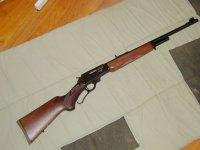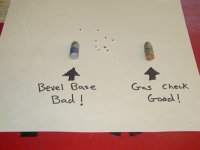canoeguy
US Veteran
Got my new Marlin 45/70 lever rifle out of layaway the other day from Gander Mountain. I loaded up some Missouri Bullet Company 405 grain cast lead flat point with Unique (16.0 grains, 1250 FPS), Trail Boss (13.0 grains, 1000 FPS) and 3031 (45.5 grains, 1597 FPS) and took the rifle to the range. Zeroed it at 50 yards with factory ammuntion, Remington 405 grain jacketed bullets, then tried my reloads...
Disapointed! All three loads key-holed or passed through the target sideways. Obviously, this rifle didn't like the Missouri Bullet Company offering. I contacted a friend who casts bullets for 45/70, shooting them through a Remington Rolling Block and a Browning single shot. He gave me three bullets to try, some Hornady 350 grain jacketed round nose, and two bullets he casts himself, a 405 grain lead flat nose gas check, and a 300 grain lead flat nose gas check.
I loaded the 350 grain jacketed Hornadys with 48 grains 3031 (1390 FPS according to my Speer manual), the 405 grain LFNGC's got 12.0 grains Trail Boss (971 FPS) and the 300 grain LFNGC's got 14.0 grains Trail Boss (1200 FPS). The rifle loved these bullets, putting them into less than 1" at 50 yards. I'll load some more and try them at 100 yards.
I am really loving this rifle, it will shoot factory jacketed ammuniton and mild cast lead (both 405 grain) to the same point of impact at 50 yards. What a hunting/survival rifle, being able to shoot small game or large with the same sight setting!
I'm thinking this rifle needs a gas check to stabilize the bullets. Anybody else have problems with 45/70 bullets loaded with no gas check?
My friend is going to introduce me to casting bullets within the next week, he has all the equipment and we'll walk through casting some of the 405 grain bullets.
Here's some pics of the rifle and targets/bullets, silver dollar shown to illustrate group size:
Disapointed! All three loads key-holed or passed through the target sideways. Obviously, this rifle didn't like the Missouri Bullet Company offering. I contacted a friend who casts bullets for 45/70, shooting them through a Remington Rolling Block and a Browning single shot. He gave me three bullets to try, some Hornady 350 grain jacketed round nose, and two bullets he casts himself, a 405 grain lead flat nose gas check, and a 300 grain lead flat nose gas check.
I loaded the 350 grain jacketed Hornadys with 48 grains 3031 (1390 FPS according to my Speer manual), the 405 grain LFNGC's got 12.0 grains Trail Boss (971 FPS) and the 300 grain LFNGC's got 14.0 grains Trail Boss (1200 FPS). The rifle loved these bullets, putting them into less than 1" at 50 yards. I'll load some more and try them at 100 yards.
I am really loving this rifle, it will shoot factory jacketed ammuniton and mild cast lead (both 405 grain) to the same point of impact at 50 yards. What a hunting/survival rifle, being able to shoot small game or large with the same sight setting!
I'm thinking this rifle needs a gas check to stabilize the bullets. Anybody else have problems with 45/70 bullets loaded with no gas check?
My friend is going to introduce me to casting bullets within the next week, he has all the equipment and we'll walk through casting some of the 405 grain bullets.
Here's some pics of the rifle and targets/bullets, silver dollar shown to illustrate group size:




